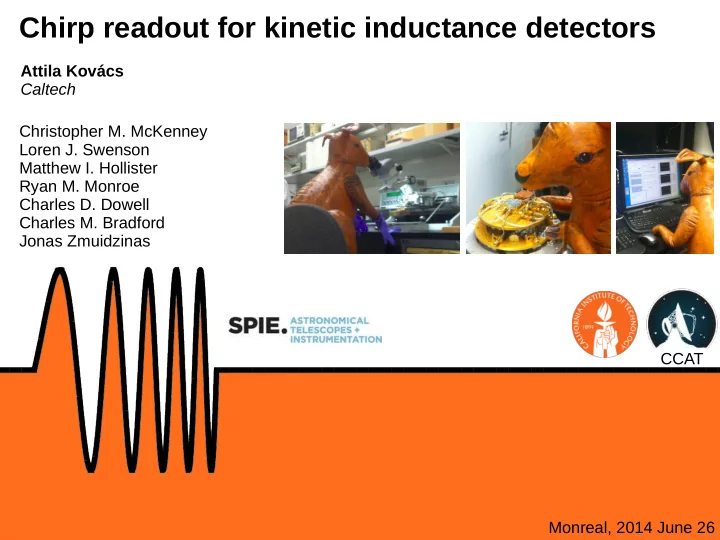

Chirp readout for kinetic inductance detectors Attila Kovács Caltech Christopher M. McKenney Loren J. Swenson Matthew I. Hollister Ryan M. Monroe Charles D. Dowell Charles M. Bradford Jonas Zmuidzinas CCAT Monreal, 2014 June 26
KIDs and their typical readout Q ~ 100,000 max. ~4000 channels / octave f < 250 MHz to process octave Attila Kovács – Chirp Readout SPIE 2014
KIDs and their typical readout 1. sweep Q ~ 100,000 max. ~4000 channels / octave f < 250 MHz to process octave Attila Kovács – Chirp Readout SPIE 2014
KIDs and their typical readout 1. sweep Q ~ 100,000 2. calibrate max. ~4000 channels / octave 3. I,Q frequency f < 250 MHz to process octave Attila Kovács – Chirp Readout SPIE 2014
Chirp 101 excitation period listening period 16 us 262 us ~2 e-foldings Requires FFTs at 200 – 250 MSPS (in ~2Q chunks) 282 us 3.6 kHz FFT FFT FFT FFT FFT Attila Kovács – Chirp Readout SPIE 2014
Components PC Host GPU Pentek board $ 4K $ 13K $ 2K (~200 W) (18 W) (80 W) ... 5000+ lines of code (C / CUDA) $ 500k for 10 5 channels $ 5 / channel 7.5 kW for 10 5 channels 75 mW / channel SWCam : Stacey et al. 9153-21 Attila Kovács – Chirp Readout SPIE 2014
Test Configuration Test Configuration 2014 January 28 – 30 MAKO 2 nd Generation Devices ( 9153-5 ) actual chirp timestream 125 – 250 MHz C. McKenney cryostat DAC ADC 2 nd Nyquist 100+ MHz LNA - 5 dB LNA - 2 dB 100+ MHz 300- MHz -30 / -40 dB MAKO +30 / +40 dB +30 dB cold v2 4K 300 K ~400 resonators, Q ~ 100k →~ +25 dB Attila Kovács – Chirp Readout SPIE 2014
First Results 1 second integration 2014 January 28-30 Attila Kovács – Chirp Readout SPIE 2014
Real-time resonance fitting observed amplitudes inverse amplitudes inverse amplitude increments Cramer-Rao a x + b lower bound: SNR √ 2 2 m σ b ⩾ π f c = -b/a Attila Kovács – Chirp Readout SPIE 2014
Noise performance Within a factor ~2 of tones (+20 dB DAC noise) NEF ~ 400 mHz s 1/2 400 mHz s 1/2 MAKO 2013: BLIP(CSO): ~80 mHz s 1/2 ~5 mHz s 1/2 BLIP(CCAT): SNR (1s) NEF PSD (df/f) 75 dB 400 mHz s 1/2 1.4 – 5.4 × 10 -18 / Hz 85 dB 130 mHz s 1/2 1.4 – 5.4 × 10 -19 / Hz 105 dB 13 mHz s 1/2 1.4 – 5.4 × 10 -21 / Hz 118 dB 3 mHz s 1/2 0.8 – 3.3 × 10 -22 / Hz increased responsivity – or – better ADCs Attila Kovács – Chirp Readout SPIE 2014
Excitation Power Suppress TLS Noise - vs - Smearing at high power levels Attila Kovács – Chirp Readout SPIE 2014
Real-time Line Matching Timestream 10 Timestream 177 channel B channel A channel A near search threshold collisions spurious features image band resonances Line matching: ordered resonances steady detector stream Attila Kovács – Chirp Readout SPIE 2014
GPU Task List accumulate decay correction FFT peak search collision check line fitting catalog matching ... @ 1 GB / sec FP ... Attila Kovács – Chirp Readout SPIE 2014
Where next? Make it (a lot) cheaper and less power hungry... + ? How to get 250 MSPS (2 nd Nyquist) NVIDIA Tegra K1 streamed to it? (ARM Cortex A15 + 192 CUDA cores) mini PCIe (x1) FPGA $ 192 ADC interface (~10 W) - or - fibre optic interface $ 10k for 10 5 channels $ 0.10 / channel 5 mW / channel 500 W for 10 5 channels Attila Kovács – Chirp Readout SPIE 2014
Advantages Advantages Direct frequency measure ( phase ) Dynamic range Uniform sensitivity Faster readout rate Insensitive to voltage noise (1/ f ) Emission ( no background ) MAKO 2013 1 DAC to rule them all... Chirp Mapping at the CSO? (August) Line intensities ( dissipation ) and widths ( Q ) Attila Kovács – Chirp Readout SPIE 2014
Recommend
More recommend